Abstract
The electrical parameters important in the fusion of plant protoplasts aligned dielectrophoretically in high-frequency alternating electric fields have been established. Protoplasts were aligned in an alternating electric field between two relatively distant (1 mm) electrodes, by dielectrophoresis induced by field inhomogeneities caused by the protoplasts themselves. This arrangement allowed ease of manipulations, large throughput and low loss of protoplasts. In analytical experiments, sufficiently large samples could be used to study pulse duration-fusion response relations at different pulse voltages for protoplasts of different species, tissues and size (mesophyll protoplasts of Solanum brevidens, Triticum aestivum, Hordeum vulgare; suspension-culture protoplasts of Nicotiana sylvestris, N. rustica, Datura innoxia and S. brevidens; root-tip protoplasts of Vicia faba, hypocotyl protoplasts of Brassica napus). The percentage of aligned protoplasts that fused increased with increasing pulse parameters (pulse duration; voltage) above a threshold that was dependant on pulse voltage. The maximum fusion values obtained depended on a number of factors including protoplast origin, size and chain length. Leaf mesophyll protoplasts fused much more readily than suspension-culture protoplasts. For both types, there was a correlation of size with fusion yield: large protoplasts tended to fuse more readily than small protoplasts. In short chains (≦five protoplasts), fusion frequency was lower, but the proportion of one-to-one products was greater than in long chains (≧ten protoplasts). In formation by electrofusion of heterokaryons between mesophyll and suspension-culture protoplasts, the fusion-frequency response curves reflected those of homofusion of mesophyll protoplasts rather than suspension-culture protoplasts. There was no apparent limitation to the fusion of the smallest mesophyll protoplast with the largest suspension-culture protoplasts. Based on these observations, it is possible to direct fusion towards a higher frequency of one-to-one (mesophyll/suspension) products by incorporating low densities of mesophyll protoplasts in high densities of suspensionculture protoplasts and by using a short fusion pulse. The viability of fusion products, assessed by staining with fluorescein diacetate, was not impaired by standard fusion conditions. On a preparative scale, heterokaryons (S. brevidens mesophyll-N. sylvestris or D. innoxia suspension-culture) were produced by electrofusion and cultured in liquid or embedded in agar, and were capable of wall formation, division and growth. It is concluded that the electrode arrangement described is more suitable for carrying out directed fusions of plant protoplasts than that employing closer electrodes.
Similar content being viewed by others
References
Bates, G.W., Gaynor, J.J., Shekhawat, N.S. (1983) Fusion of plant protoplasts by electric fields. Plant Physiol. 72, 1110–1113
Bokelmann, G.S., Roest, S. (1983) Plant regeneration from protoplasts of potato (Solanum tuberosum cV. ‘Bintje’). Z. Pflanzenphysiol. 109, 259–265
Evans, D.A. (1984) Protoplast fusion. In: Handbook of plant cell culture, vol. 1: Techniques for propagation and breeding, pp. 291–321, Sharp, W.R., Ammirato, O., Yamada, Y., Evans, D.A., eds., Macmillan, New York
Finaz, C., Lefevre, A., Teissie, G. (1984) A new highly efficient technique for generating somatic hybrids. Exp. Cell Res. 150, 477–482
Glimelius, K., Ottosson, A. (1983) Improved culture ability of the genus Brassica by using hypocotyl as a source of protoplasts. (Suppl.) Experientia 45, 64–65
Horsch, R.B., King, J., (1983) Isolation of an isoleucine-valinerequiring auxotroph from Datura innoxia cell cultures by arsenate counterselection. Planta 159, 12–17
Jones, M.G.K., Maddock, S.E., Karp, A. Nelson, R.S., Creissen, G.P., Foulger, D., Bright, S.W.J. (1984) Tissue and protoplast culture-a novel way to new crop plant varieties. In: The world biotech report 1984, vol. 1: Europe, pp. 443–454, Online: Pinner
Kao, K.N., Machayluk, M.R. (1974) A method for high frequency intergeneric fusion of plant protoplasts. Planta 115, 355–367
Koop, H.U., Dirk, J., Wolff, D., Schweizer, H.G. (1983) Somatic hybridization of two selected single cells. Cell Biol. Int. Rep. 7, 1123–1128
Larkin, P.J. (1976) Purification and viability determination of plant protoplasts. Planta 128, 213–216
Murashige, T., Skoog, F. (1962) A revised medium for rapid growth and bioassays with tobacco tissue cultures. Physiol. Plant. 15, 473–497
Negrutiu, I., Cattoir-Reynearts, A., Verbruggen, I., Jacobs, M. (1984) Lysine overproducer mutants with an altered dihydrodipicolinate synthase from protoplast culture of Nicotiana sylvestris (Spegazzini and Comes). Theor. Appl. Genet., 68, 11–20
Nelson, R.S., Creissen, G.P., Bright, S.W.J. (1983) Plant regeneration from protoplasts of Solanum brevidens. Plant Sci. Lett. 30, 355–362
Patnaik, G., Cocking, E.C., Hamill, J., Pental, D. (1982) A simple procedure for the manual isolation and identification of plant heterokaryons. Plant Sci. Lett. 24, 105–110
Pilwat, G., Richter, H.-P., Zimmermann, U. (1981) Giant culture cells by electric field-induced fusion. FEBS Lett. 133, 169–174
Richter, H.-P., Scheurich, P., Zimmermann, U. (1981) Electric field-induced fusion of sea urchin eggs. Dev. Growth Differ. 23, 479–486
Scheurich, P., Zimmermann, U., Schnabl, H. (1981) Electrically stimulated fusion of different plant cell protoplasts. Plant Physiol. 67, 849–853
Senda, M., Takeda, G., Abe, S., Nakamura, T. (1979) Induction of cell fusion of plant protoplasts by electrical stimulation. Plant Cell Physiol. 79, 1441–1443
Shepard, J.F. (1980) Abscisic acid-enhanced shoot initiation in protoplast-derived calli of potato. Plant Sci. Lett. 18, 327–333
Teissie, J., Knutson, V.P., Tsong, T.Y., Lane, M.D. (1982) Electric pulse-induced fusion of 3T3 cells in monolayer culture. Science 216, 537–538
Tempelaar, M.J., de Both, M.T.J., Versteegh, J.E.G. (1982) Measurement of SCE frequencies in plants: a simple Feulgen-staining procedure for Vicia faba. Mutat. Res. 103, 321–326
Uchimaya, H., Murashige, T. (1974) Evaluation of parameters in the isolation of viable protoplasts from cultured plant cells. Plant Physiol. 54, 936–944
Watts, J.W., King, J.M. (1984) A simple method for large scale electrofusion and culture of plant protoplasts. Bioscience Rep. 4, 335–340
Zimmermann, U. (1982) Electric field-mediated fusion and related electricalphenomena. Biochim. Biophys. Acta 694, 227–277
Zimmermann, U., Scheurich, P. (1981) High frequency fusion of plant protoplasts by electric fields. Planta 151, 26–32
Zimmermann, U., Scheurich, P., Pilwat, G., Benz, R. (1981) Cells with manipulated functions: new perspectives for cell biology, medicine and technology. Angew. Chemie 20, 325–344
Author information
Authors and Affiliations
Rights and permissions
About this article
Cite this article
Tempelaar, M.J., Jones, M.G.K. Fusion characteristics of plant protoplasts in electric fields. Planta 165, 205–216 (1985). https://doi.org/10.1007/BF00395043
Received:
Accepted:
Issue Date:
DOI: https://doi.org/10.1007/BF00395043




